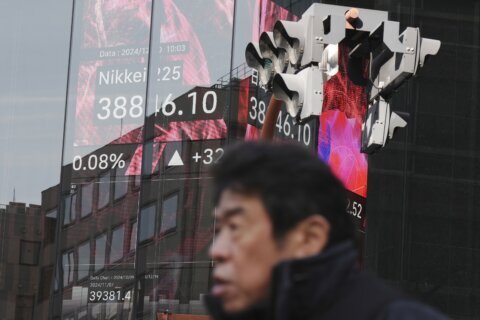The impact of inflation on stocks and bonds remains a concern for many investors, especially those who are planning to retire soon and will need the income from their portfolios.
Consumer spending and wages are two key drivers of inflation, and both have rebounded since the start of the global pandemic. Corporate earnings have also grown as the overall economy improves, while the Federal Reserve has conducted a large amount of bond buying.
Headline inflation, which includes the prices of food and energy, rose as supply chain bottlenecks and the rising number of coronavirus cases affected consumer products such as cars. For the 12 months ended in August, the consumer price index showed prices increasing 5.3%. Core inflation, which excludes volatile food and energy prices, was 4% on a year-over-year basis. For comparison, the Fed’s long-term inflation benchmark is 2%. Here’s what you need to know about elevated inflation in 2021:
— How inflation influences your portfolio.
— Sectors that perform well during inflationary periods.
— Do you need to rebalance your portfolio?
[Sign up for stock news with our Invested newsletter.]
How Inflation Influences Your Portfolio
Inflation typically has a less direct effects the returns of stocks than on bonds, since it diminishes the purchasing power of the cash flow.
“Stocks generally hold up better with inflation, especially if the inflation comes with growth,” says Jodie Gunzberg, managing director of CoinDesk Indexes at TradeBlock.
The U.S. has showed strong GDP growth in recent quarters, due to higher consumer spending and investments made by companies as the economy rebuilds, said Constance Hunter, chief economist at KPMG, a New York-based consulting company.
“Right now we have GDP rebounding strongly, and driving that rebound is two important things,” she says. “The first is a strong rebound in goods consumption — the change in goods consumption in the first half of 2021 was more than the change in 2018 and 2019 combined. The second thing is an increase in investment, particularly investment in technology that is likely to keep productivity elevated for years to come.”
Meanwhile, bond prices and returns are more heavily affected by inflation than stocks, especially if that inflation is here to stay.
“Bond prices would be materially mispriced if inflation is running higher than expectations, and the Fed would be viewed as seriously behind the curve and the bond vigilantes would return,” which in turn would depress bond prices and push up interest rates, says Michael Underhill, chief investment officer of Capital Innovations in Pewaukee, Wisconsin. Underhill expressed doubts about Fed Chairman Jerome Powell’s pronouncements that recent acute inflation is transitory, citing sharp rises in housing and labor costs.
If inflation continues to run high, it will require the Fed to tighten monetary policies and increase interest rates to discourage additional borrowing from companies and consumers, says Brian Menickella, managing partner at the Beacon Group, a King of Prussia, Pennsylvania-based financial advisory company. This move will drive the value of the dollar down as the cost of goods will increase and the spending power of the dollar declines, he says.
“This reduces the buying power of bond dividend future cash flow,” Menickella says. “This will ultimately raise yields, which inversely drops the price of the bond. Rising prices over time reduces the purchasing power of each interest payment a bond makes. When investors worry that a bond’s yield won’t keep up with the rising costs of inflation, the price of the bond drops because there is less investor demand for it.”
But the exact impact that inflation has on assets remains difficult to estimate, Gunzberg says.
“Clearly the current streak is nowhere near the extended periods of high inflation ending in the early 1980s,” she says. “Given that we have limited observations of high inflation in recent times, it is difficult to estimate how long the inflationary impact on assets will last.”
[SEE: 9 High Dividend Yield Stocks for 2021.]
Sectors That Perform Well During Inflationary Periods
Higher inflation would prove to be “bad news for longer-duration equities such as growth stocks and more favorable to inflation hedge equities such as real assets, energy, materials and real estate,” Underhill says. “Equities in general perform better in a moderate increasing-inflation backdrop versus bonds.”
Real estate has historically performed well during inflationary periods. For example, housing prices are up by 20% in 2021 compared with pre-pandemic levels, Hunter says.
“However, since inflation is a concurrent to lagging indicator, current prices do not tell you what to invest in going forward necessarily,” she says. “Generally speaking, when companies are able to raise prices and maintain margins, it is good for their stock prices.”
The real question comes down to productivity, Hunter says.
“Firms that are investing in digital technology such as artificial intelligence and machine learning are the most likely to be investing in their future ability to generate firm level productivity,” she says.
Do You Need to Rebalance Your Portfolio?
People who do not plan on retiring for at least a couple of decades do not need to reallocate their current assets, Hunter says.
“Don’t worry about inflation with regard to portfolio allocation if you are 20 to 30 years away from retirement and you do not think you will need the money before then,” she says. “It is prudent to have a greater allocation to equities than bonds.”
Some investors, especially those closer to retirement, prefer to allocate money to investments that hedge against inflation.
One such investment is the Quadratic Interest Rate Volatility and Inflation Hedge exchange-traded fund (ticker: IVOL), which is actively managed and provides exposure to Treasury inflation-protected securities, known as TIPS, and uses options to hedge against shifts in the yield curve, says Todd Rosenbluth, head of exchange-traded fund and mutual fund research at New York-based CFRA Research. IVOL has a low correlation to stocks, bonds, gold, high-yield credit and the VIX, a volatility index. It was launched in May 2019 and has an expense ratio of 1.05% and a one-year return of 5.42%.
The Horizon Kinetics Inflation Beneficiaries ETF ( INFL), which launched in January 2021, is actively managed and owns stocks of asset-light companies that can benefit amid higher inflation. It owns Archer-Daniels-Midland Co. ( ADM), Charles River Laboratories International Inc. ( CRL) and Intercontinental Exchange Inc. ( ICE). The fund has an expense ratio of 0.85% and a year-to-date return of 17%.
[Read: I Just Retired. How Would I Recover From a Market Downturn Now?]
There are also assets, such as commodities, that may provide more inflation protection than stocks or bonds.
“(One) feature of commodities that make them a strong inflation hedge is that they are priced in U.S. dollars, so as the dollar falls, all else equal, it is good for commodities,” she says.
Bitcoin, commodities and energy stocks are the most sensitive to inflation, so rotating into them from bonds, hedge funds or other stocks “may be an effective strategy for inflation hedging,” Gunzberg says. “However, Bitcoin, commodities and energy stocks also are relatively volatile, so investors need to evaluate how much risk they are willing to tolerate for higher inflation beta.”
Bitcoin is also priced in U.S. dollars, and the cryptocurrency is showing to be even more sensitive to inflation. “This means investors may get similar inflation protection with 1% allocated to Bitcoin as with 5% allocated to commodities,” she says.
More from U.S. News
6 Best High-Dividend Mutual Funds and ETFs
Why You Should Add Midcaps to Your Portfolio
How to Beat Inflation in 2021 originally appeared on usnews.com







